jerseys online
wig outlet
Human hair Wigs
sex toys for couples
jordan store
nfl san francisco 49ers
nike air max 90
nike air jordan 4 black canvas
make a custom jersey
custom jerseys
custom football jerseys
nike air max 270 mens sale
adidas online shop
adidas yeezys
Human Hair wigs
In this Pandemic when work from home has become the new normal, home exercise is the only option and entertainment is restricted to our bedrooms to our living rooms. It is quite common to sit & sleep in the wrong postures to break the monotony which is resulting in body aches and lower back pain leaving us uncomfortable the entire day. If that’s happening to you, trust me you are not alone.
The Global Burden of Disease study named lower back pain as one of the primary causes of disability across the globe. Back pain is often the result of stress or strain from bad posture, awkward sleeping positions, and other lifestyle habits. We have listed some of the best sleeping positions to try in case of lower back pain, as well as some other things you can do to get a better night’s rest.
1. Keep a pillow between your knees while sleeping
If sleeping straight with your back on the mattress doesn’t give you comfort, one should try to sleep on the side. Allow your right or left shoulder to make contact with the mattress, keep a pillow between your knees. In case if there’s a gap between the waist and your mattress, use a small pillow for added support. One should avoid sleeping on the same side it might cause muscle imbalance and even scoliosis. Sleeping sideways alone doesn’t help, it’s important to keep a pillow in between for better alignment of hips, pelvis, and spine.
2. Try sleeping in the fetal position on a preferred side
Share on Pinterest
Try sleeping in the fetal position in case of herniated disc. First Lay on your back, then roll over gently onto your side and tuck your knees toward your chest and gently curl your upper body toward your knees. Switching sides is extremely important to avoid imbalances. Herniation happens when a portion of a spinal disc pushes outside of its usual space, causing a lot of nerve pain, weakness, and more. Curling your chest into a fetal position opens the space between the spinal column.
3. Sleep with a pillow under your abdomen
Usually, people say sleeping on your stomach is actually bad for back pain. It is partially true because may add to the stress on the neck. If you are resting on your stomach, you don’t have to try another position.
1. To release some of the pressure off your back you can place a pillow under your pelvis and lower
2. People with degenerative disc disease may benefit the utmost by sleeping on their stomachs with a pillow underneath. It can release any strain that is located in the space between the discs.
4. Place a pillow under your knees while sleeping on the back
Sleeping on their back is the best position to relieve back pain. Place a pillow underneath your knees as it helps to keep the spine neutral. The pillow is important as it helps to keep the curve in your lower back. You can also place a rolled-up towel under the small gap of your back for added support.
When you sleep on your back, the bodyweight is evenly distributed and as a result, there is less strain on the pressure points. It also helps in better alignment of the spine and your internal organs.
5. Sleep in a reclined position on your back
Share on Pinterest
This position is comfortable for those you have isthmic spondylolisthesis. A recliner bed gives comfort to people with this problem. One can invest in an adjustable bed it’s easier to sleep with the best alignment and support. Reclining may be helpful for the back because it makes an angle between the thighs and trunk. This position helps to reduce the pressure on the spine.
Ensure right Alignment while sleeping
Keeping proper alignment of your spine is the most important part of the balance, choosing the right position helps. Emphasize precisely on aligning your ears, shoulders, and hips. You may spot gaps between your body and the bed that strain your muscles and spine. To fill gaps a pillow can be used to reduce stress. Be careful while turning in bed, alignment can be affected during twisting and turning motions as well.
Reiterating the fact that body alignment is extremely important for your spine, hence a pillow should be used to support your head and neck. If you sleep on your back, your pillow should entirely fill the space between your neck and the mattress. In case you are sleeping on the sides, try using a thicker pillow to keep the head in line with the rest of your body in this position. Also, one very important tip never to place the pillow under your shoulders. While you are planning to change your sleeping positions also consider changing your pillow every 18 months or so as apart from losing its original shape your pillow holds a lot of allergy triggers like mold and dust mites. Consider thinner pillows if you are a back sleeper or a stomach sleeper to support your neck, memory foam, or a water pillow for a firm and all-over support is a good option if you are a side sleeper.
Tips to choose the right mattress
Doctors used to recommend very firm orthopedic mattresses to people with lower back pain but as some recent surveys suggest people who use extremely firm mattresses may have the poorest sleep. On the other hand, a soft mattress won’t help either with alignment. If you have the budget to buy something new, try choosing a firm or medium-firm mattress made with good-quality innerspring or foam. You can also improve the innerspring mattress by adding a memory foam mattress topper. Keeping your mattress on the floor can also be considered to see if lessening the movement of the springs helps with the pain.
www.arogyada.in


